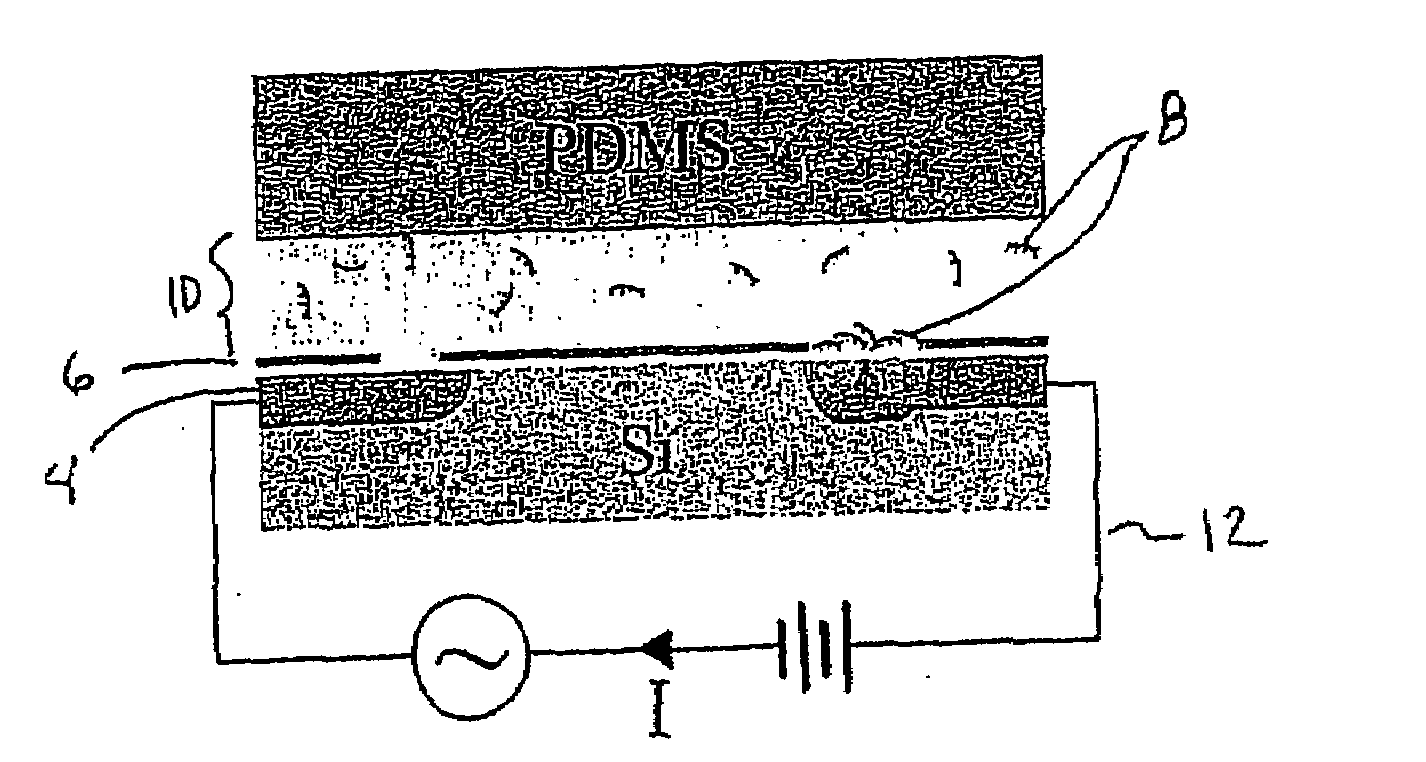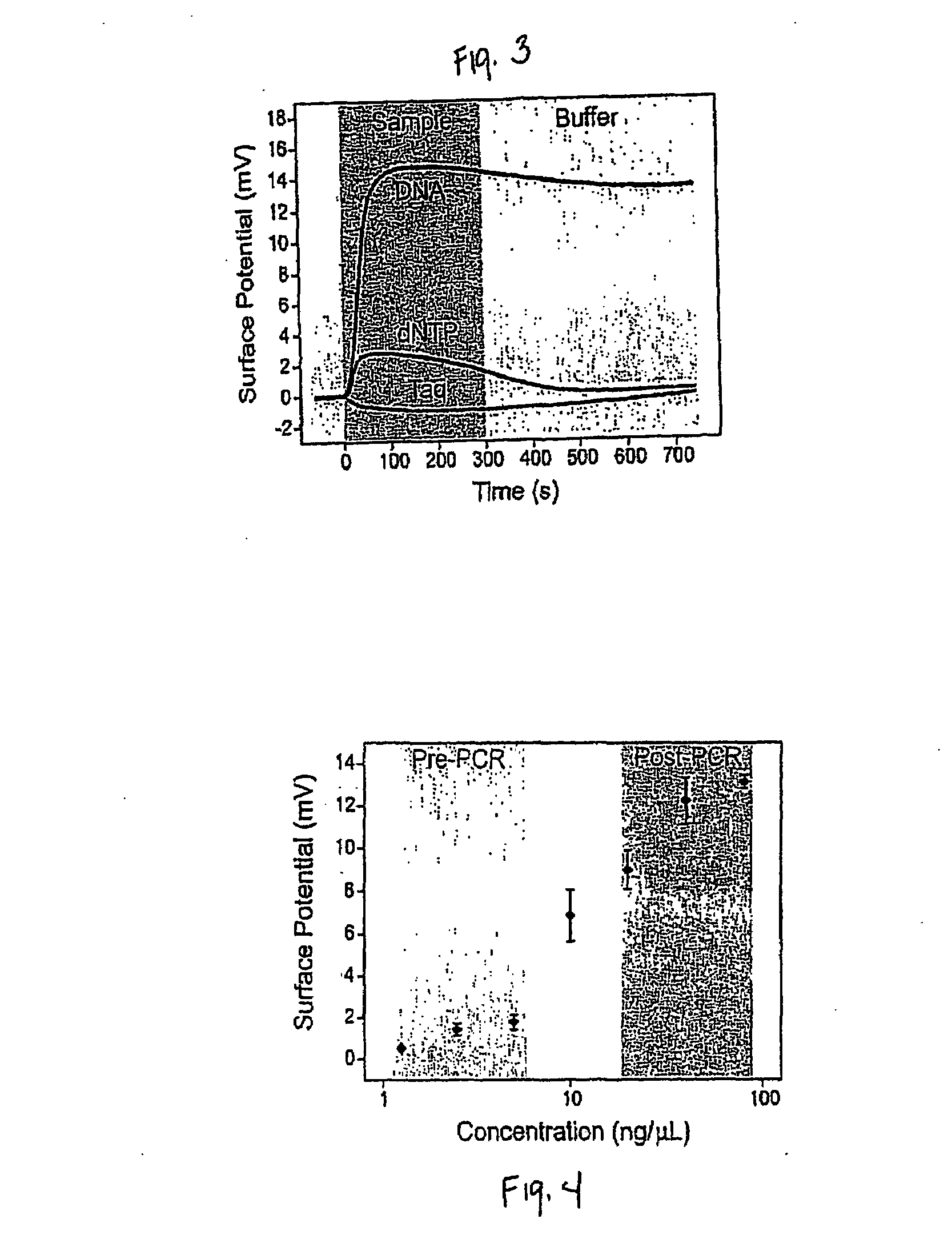Method and apparatus for label-free electronic real-time double-stranded nucleic acid detection
a technology of electronic real-time double-stranded nucleic acids and detection methods, which is applied in specific use bioreactors/fermenters, laboratory glassware, biomass after-treatment, etc., can solve the problems of limiting the applicability of double-stranded nucleic acid detection and optional quantification, requiring extensive optimization or induce inhibitor effects, and limiting the scalability and robustness of miniaturization measuremen
- Summary
- Abstract
- Description
- Claims
- Application Information
AI Technical Summary
Benefits of technology
Problems solved by technology
Method used
Image
Examples
example 1
Fabrication of Device for Label-Free Detection of Double-Stranded Nucleic Acids
[0042]As shown in FIG. 1, one embodiment of the present invention demonstrates quantitative label-free monitoring of product formation in an unprocessed PCR mixture using a microelectronic sensor based on silicon field-effect. High sensitivity to the intrinsically charged PCR product 8 was achieved by depositing a thin layer of PLL 6 on the sensing surface 4. In this configuration, the sensor could quantitatively and reproducibly differentiate concentrations of DNA in the PCR relevant range of approximately 1-80 ng / μL. After measuring a particular concentration, the sensor was readily recovered without degradation of its sensitivity by depositing another layer of PLL 6 on the sensor surface 4. Therefore, the technique was capable of sequentially analyzing PCR products 8 at various stages of the reaction through layer-by-layer assembly. Furthermore, this method embodiment was performed in microfluidic chan...
example 2
Monitoring Formation of Polyelectrolyte Multilayers
[0045]Functionalization of the surface was performed by exposing the sensor surface to 0.2 mg / ml poly-L-lysine hydrobromide (PLL, MW 15,000-30,000, Sigma) in PCR buffer for 3 minutes then rinsing off the unbound species with PCR buffer for 10-15 minutes. A DNA response curve was generated by diluting stock 50 bp DNA ladder (New England BioLabs, Ipswich, Mass.) to various concentrations with PCR buffer. Human genomic DNA was purchased from Maxim Biotech, Inc. (South San Francisco, Calif.). For all binding experiments on PLL-coated surfaces, the sensors were exposed to analytes for 5 minutes followed by a 5 minute wash during which time the signal is recorded.
[0046]The sensor behaved as a variable capacitor whose impedance value was sensitive to the charge density of surface bound molecules. See Refs. 14 and 15. The sensor was used to monitor the formation of polyelectrolyte multilayers through alternating injections of PLL, a positiv...
example 3
Response of Sensor to Different DNA Concentrations
[0047]The sensor was tested for its response to DNA at concentrations in the range relevant to PCR conditions. DNA ladder of lengths between 50 bp to 1350 bp (representative of various PCR product sizes) were chosen to obtain the DNA mass concentration response of the sensor. The DNA mass concentration was empirically determined using Labchip kits wherein product concentrations between 20 and 50 ng / μL are obtained from various saturated PCR experiments. The dependence of surface potential change on DNA concentrations between 2.5 and 80 ng / μL was tested. The device was most sensitive to DNA concentrations between 10 ng / μL and 40 ng / μL, a range relevant to PCR quantifications.
[0048]The measurement method has been previously reported in detail. See Ref. 6. Briefly, a 4 kHz, 50 mVpp ac voltage was delivered to the on-chip gold signal electrode. The resulting alternating current through the sensor was amplified and converted by a lock-in ...
PUM
| Property | Measurement | Unit |
|---|---|---|
| concentrations | aaaaa | aaaaa |
| areas | aaaaa | aaaaa |
| concentrations | aaaaa | aaaaa |
Abstract
Description
Claims
Application Information
 Login to View More
Login to View More - R&D
- Intellectual Property
- Life Sciences
- Materials
- Tech Scout
- Unparalleled Data Quality
- Higher Quality Content
- 60% Fewer Hallucinations
Browse by: Latest US Patents, China's latest patents, Technical Efficacy Thesaurus, Application Domain, Technology Topic, Popular Technical Reports.
© 2025 PatSnap. All rights reserved.Legal|Privacy policy|Modern Slavery Act Transparency Statement|Sitemap|About US| Contact US: help@patsnap.com



